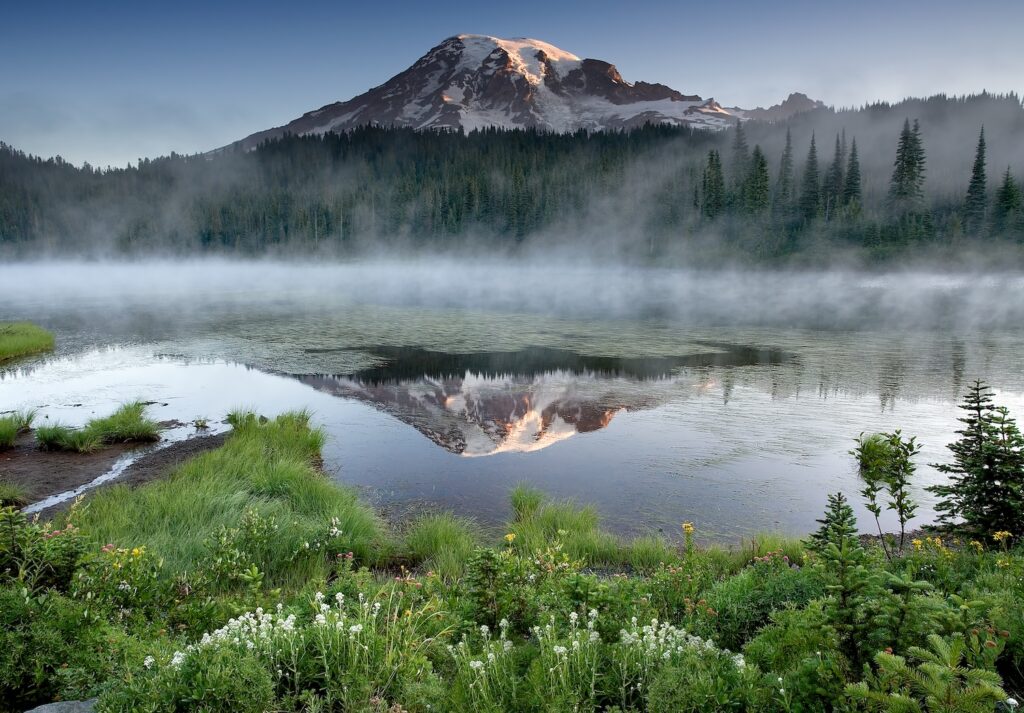Just a couple of hours from Seattle and Portland, Mount Rainier National Park is one of the Pacific Northwest’s most iconic destinations. Towering glaciers, vibrant wildflowers, and sweeping alpine meadows await across its many park entrances. But the best time to visit Mount Rainier? That depends entirely on the kind of trip you’re dreaming about.
At TMC Vacation Rentals, we’re lucky to be located just 25 miles from the Stevens Canyon Entrance: the scenic southeast corner of the park. With cozy cabins right along the Cowlitz River, we host guests year-round who want easy access to nature’s best show, no matter the time of year.
Here’s your complete guide to experiencing Mount Rainier by season, including insider tips on what to pack, what to expect, and why every season has its own magic.
In This Article:
- Mount Rainier by Season – what to expect
- Essential Visitor Tips
- FAQs About the Best Time to Visit Mount Rainier
- Where to Stay Near the Park
Spring (April to June): Quiet Trails, Rushing Waterfalls, and Early Fishing
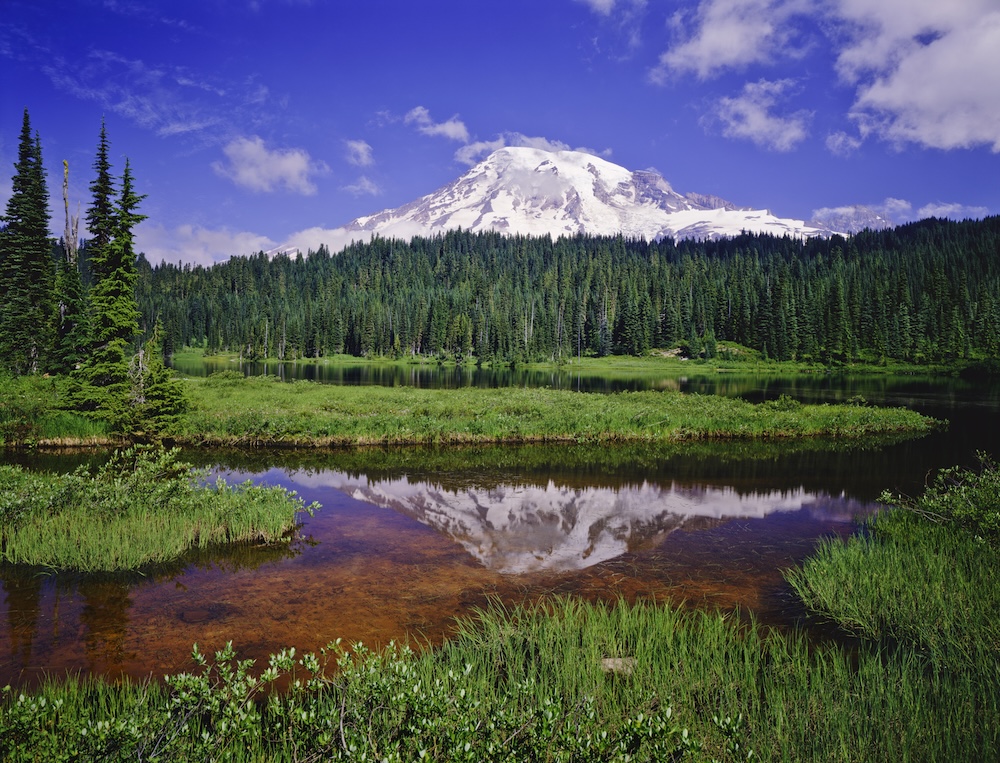
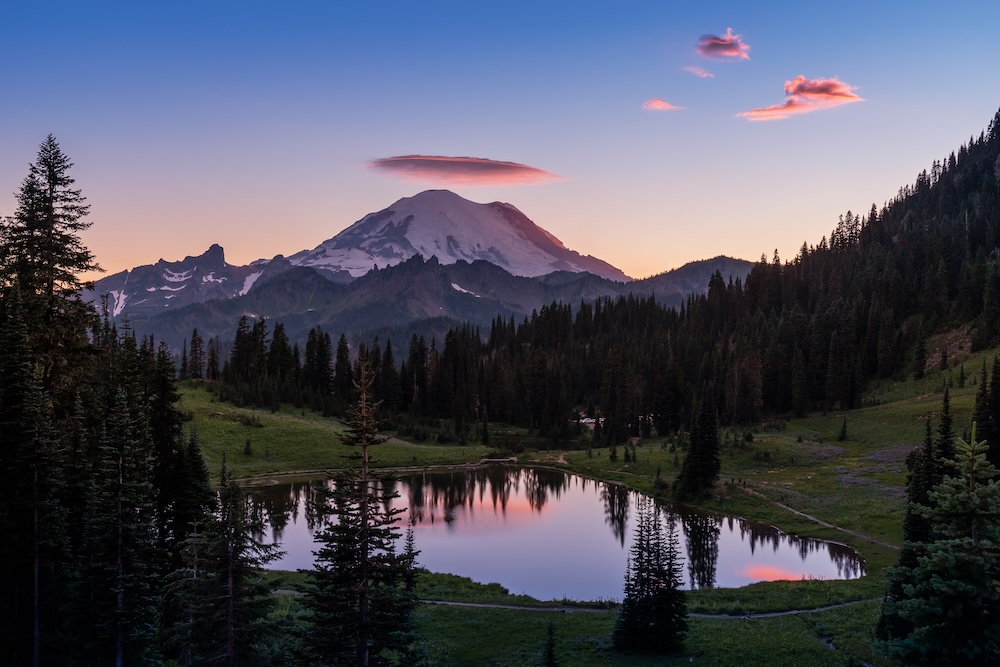
Spring is a season of change on the mountain. Snowmelt feeds powerful waterfalls like Narada Falls, while lower elevations around the Carbon River entrance start to bloom with early wildflowers. During these months, higher trails and the Sunrise Visitor Center area may still be covered in snow, but spring rewards visitors willing to explore the rainforest scenery in the northwest corner of the park.
It’s also a good time for fishing enthusiasts. The Cowlitz River nearby begins to wake up for spring anglers (just remember, if you’re casting for salmon or steelhead, you need a state catch record card.)
Pros:
- Fewer crowds and easier parking
- Full waterfalls and lush greenery
- Fishing opportunities reopen as rivers thaw
Cons:
- Higher-elevation trails and roads still closed
- Road conditions can be unpredictable
Packing Tips:
- Waterproof hiking boots
- Warm layers and a rain jacket
- Trekking poles for muddy trails
Best for: Waterfall photographers, early-season hikers, and fishing trips
Summer (July to Early September): Peak Trails, Wildflowers, and Family Adventures
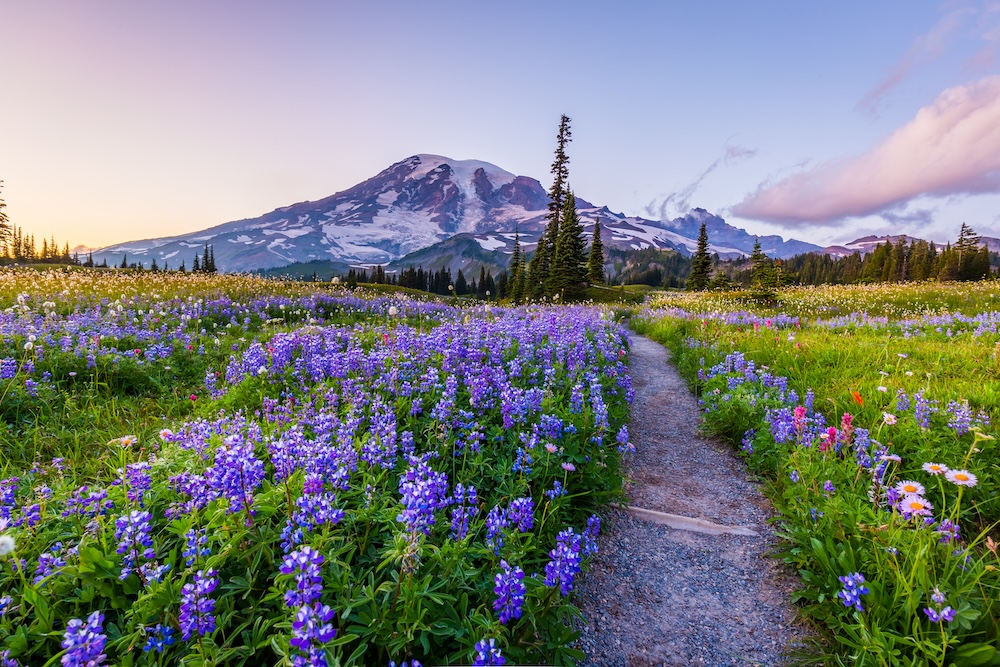
July and August are the most popular months for a trip to Mount Rainier, and for good reason. Nearly all park areas, including the famous Paradise area, are accessible. The meadows explode into color during wildflower season: don’t miss our Ultimate Guide to Wildflowers of Mount Rainier for details!
Summer is also prime time for hiking, sightseeing, and fly fishing along the Cowlitz River.
Because it’s peak season, expect more traffic at park entrances like Nisqually and White River. The National Park Service may also require a timed entry reservation system, so plan ahead to avoid delays.
Pros:
- Full trail access
- Wildflower season in late July
- Ideal conditions for hiking, exploration, and programs like Junior Rangers for kids
Cons:
- Heavy traffic and crowds
- Required reservations at Paradise and Sunrise
- Higher lodging rates
Packing Tips:
- Sun protection and bug spray
- Layered clothing (mornings are cool)
- Print or download your park pass in advance
Best for: First-time visitors and families, hikers
Fall (Mid-September to October): Fall Colors, Crisp Days, and Quiet Exploration
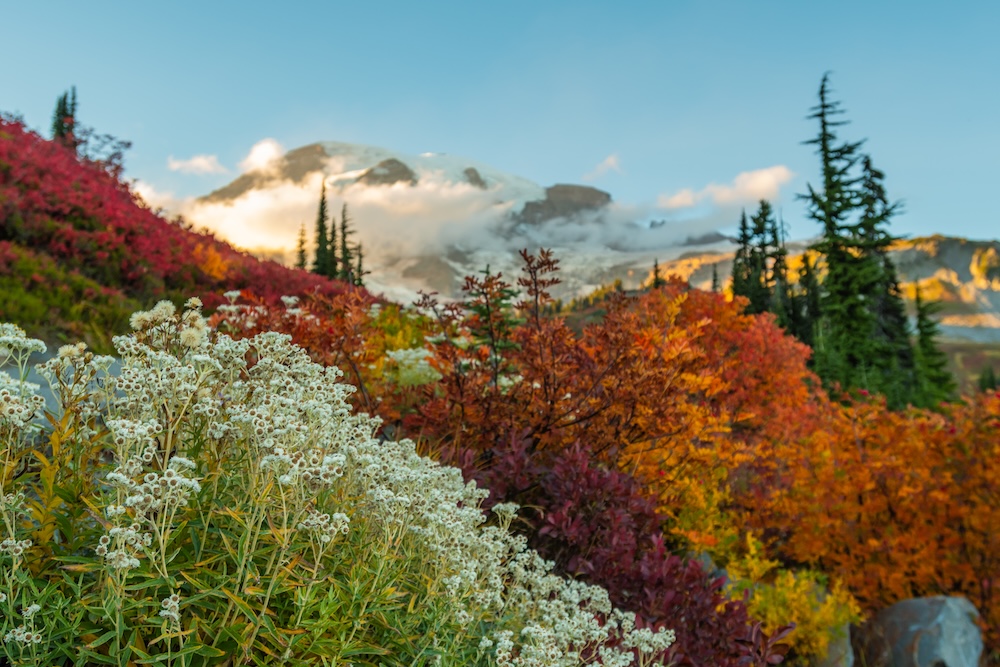
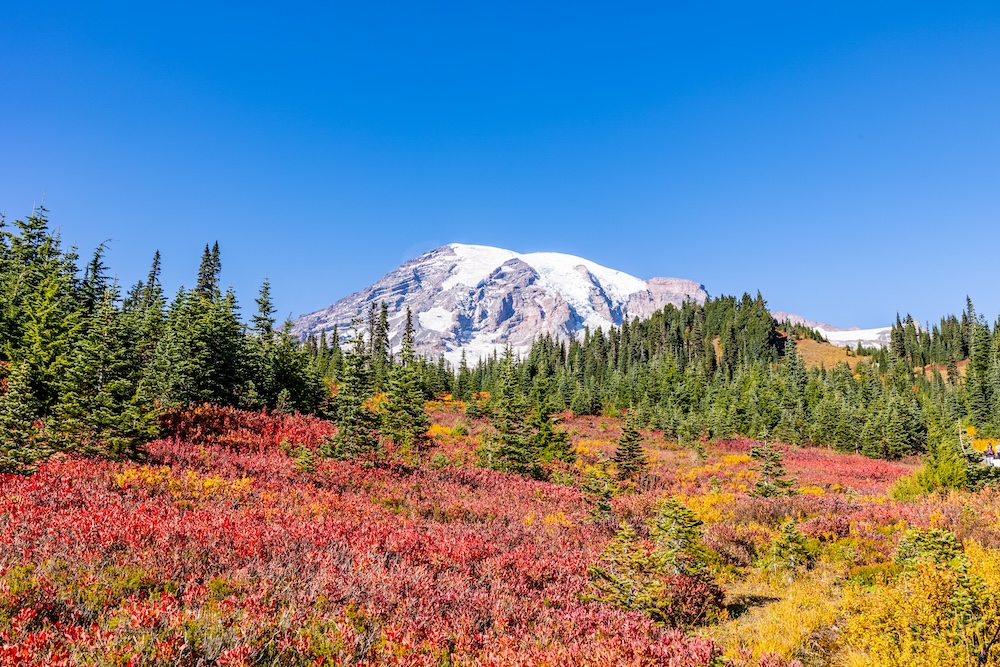
Fall is one of the best-kept secrets for visiting Mount Rainier. Early fall brings breathtaking fall colors across the Paradise and Stevens Canyon areas, especially in late September. The southeast corner of the park feels quieter, offering a slower pace ideal for hiking along the scenic trails before winter sets in.
By mid-to-late October, snow often closes high-elevation roads, but lower elevation trails near Longmire and the Carbon River (which offers foot and bike access beyond the ranger station) remain accessible longer into the season.
The Skyline Trail is recommended for gorgeous views of Mount Rainer, Reflection Lake, and Myrtle Falls. This 5.6-mile loop can be a bit of a challenge, but if you’re up for it, it’s well worth the effort.
Pros:
- Brilliant fall colors without peak crowds
- Ideal hiking temperatures
- Easier road access early in the season
Cons:
- Shorter daylight hours
- Variable weather
Packing Tips:
- Lightweight jacket and hiking layers
- Waterproof shoes
- Headlamp or flashlight for early sunsets
Best for: Couples, photographers, experienced hikers, anglers chasing fall runs
Winter (November to March): Snowshoeing, Cross-Country Skiing, and Snowy Serenity
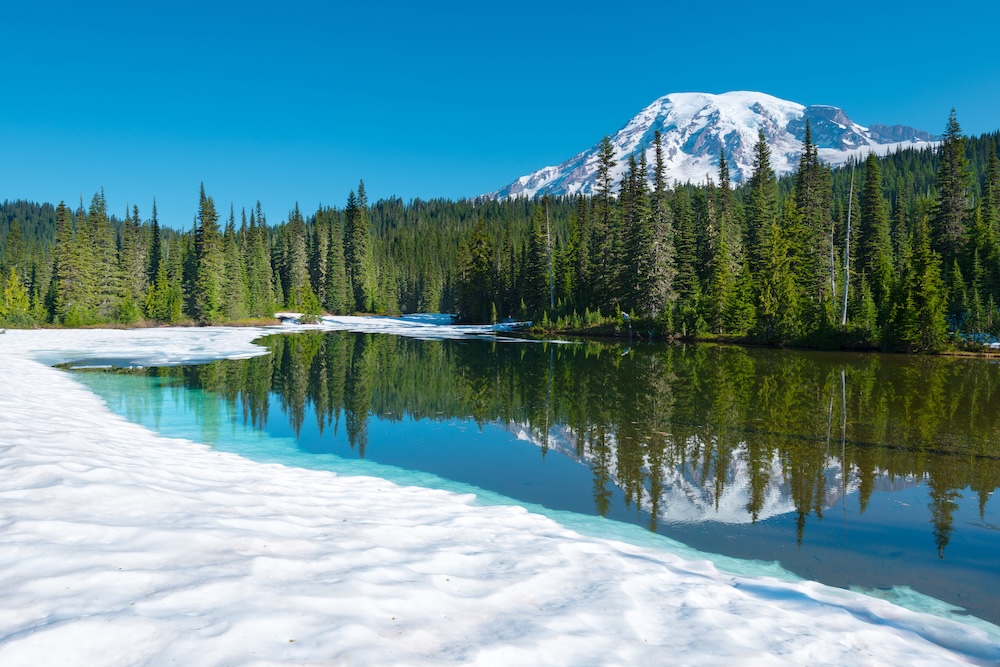
Winter transforms Mount Rainier into a snow-covered wonderland. The Nisqually Entrance in the southwest corner remains open year-round (weather permitting), giving visitors a chance to snowshoe, sled, or glide across the mountain on cross-country skis.
If you’re visiting Packwood, WA, in winter, prepare for a true adventure – after a day at the park, you can visit White Pass Ski Area for even more fun! Located just 9 miles from town, it’s one of the best ski resorts in the PNW.
This time of year, snow chains are required to enter Mount Rainier Park, and you should always check current weather and road conditions before heading out, regardless of where you’re spending the day.
Pros:
- Empty trails and stunning snowy views of Mount Rainier
- Winter sports opportunities
- Cozy cabin getaways with hot tubs and roaring fires
Cons:
- Limited access to park areas and certain amenities
- Dangerous driving conditions without preparation
Packing Tips:
- Snow chains and emergency kit
- Thermal layers and waterproof outerwear
- Battery packs and non-perishable snacks
Best for: Snowshoers, solitude seekers, winter wildlife spotters
Mount Rainier Visitor Basics: What You Need to Know
- Park Entrance Fee: $30 per vehicle (valid for seven consecutive days), or $15 per person on foot/bike. The park does not accept cash.
- Annual Pass: Mount Rainier Annual Pass is $55, good for unlimited entry for 12 months
- Fishing: A Washington State Fishing License is not required; however, a Washington State Catch Record Card is required if you’re catching salmon and steelhead. Learn more about fishing regulations at the National Park Service Mount Rainier page.
- Timed Entry: Some entrances, like the Paradise Corridor and the Sunrise Corridor, may require reservations during summer months. You can make your reservations via the National Park Service.
- Weather: Be ready for quick weather changes any time of year. Check Packwood weather updates here.
Plan Your Packwood Adventure

No matter the time of year, a trip to Mount Rainier offers a world of discovery, from rushing waterfalls to meadows full of wildflowers to peaceful snow-covered trails. And when you book your stay with TMC Vacation Rentals, you’ll be right where you want to be: close to the adventure, but away from the crowds.
Book your Packwood cabin today and experience Mount Rainier’s beauty in every season.
FAQs: Best Time to Visit Mount Rainier
July and August are the most popular times thanks to clear weather and wildflower displays. Early fall (September) offers colorful foliage with fewer crowds.
Absolutely! Late July through early August is peak bloom season. Check out our full wildflower guide here.
Packwood, Washington offers easy access to the Stevens Canyon Entrance and Paradise area. Book a cozy cabin with TMC Vacation Rentals.
Even in July and August, higher elevations stay cool, with daytime temps ranging from the 50s to 70s. Pack layers and check forecasts!

